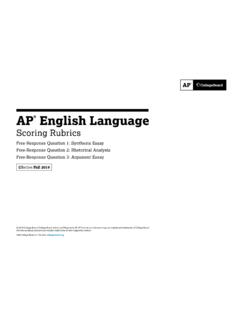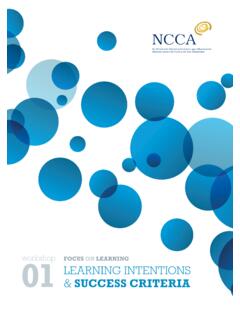Transcription of COLLEGE WRITING RUBRICS - ed
1 ARTICLES. COLLEGE WRITING RUBRICS . By BRENT MUIRHEAD * JILLIAN SKELTON **. *-** Faculty, Doctoral Dissertation Mentor, University of Phoenix. ABSTRACT. The discussion will describe how RUBRICS can help to provide effective assessment criteria for evaluating written assignments in COLLEGE undergraduate classes. A student-centered theory focus will highlight how valuable teacher/student communication can help lead to improving student WRITING . RUBRICS can be a practical way to improve feedback, reduce student grade issues and provide accurate and timely information on student WRITING skills. Keywords: Assessment, RUBRICS , Feedback, Grades, Personalize Education. INTRODUCTION use descriptive language in their written and verbal The teacher's assessment strategies provide a relational comments to their students. Teachers must cultivate prompt for students who gain insights into their work, dialogues with their students that foster open minded whether it be in-class assignments or homework.
2 Learning attitudes. The language of assessment must be Evaluating the teaching and learning process involves a caring and honest while providing insights that helps the host of activities such as creating course objectives, individual have a clear picture of their academic work gathering data from various sources and often assigning (Angelo & Cross, 1993; Paulos & Mahoney, 2008). grades for student work. Relevant assessment methods Teacher's Perspective should accurately inform both the teacher and student The instructor's RUBRICS can help improve communication about the quality of the learning experiences. about the nature and value of the assessment and the Assessments should produce a rich understanding of grading of student work (Rasheed, Aslam, & Sarwar, 2010). student learning and provide the necessary information A student-center philosophy, using RUBRICS , and having to improve future educational experiences.
3 It requires learners review their feedback will help them better asking questions that help to evaluate the effectiveness of understand assessment practices and goals. Learners of the teaching practices and curriculum plans (Huba & any age will work as hard as expected by their instructors, if Freed 2000). One such method is a grading rubric that the expectations are clearly expressed and documents an instructor's objectives for a student. The demonstrated. The learners want to understand what a learner feels confident in what their teacher is requiring of teacher is looking for in a paper or an assignment. RUBRICS their work and has a positive outlook of the grading can provide the needed structure, guidelines and process. support. A rubric can help the learners understand what The student-centered model of learning encourages the teacher wants while creating a sound basis for teachers to view their students as academic partners who productive teacher and student interaction (Fluckiger, work together to produce dynamic learning experiences.)
4 2010). Teachers must be willing to adapt their instructional If a teacher has never taught a particular group of methods to meet student learning needs. Boud (1995, p. students, it is crucial to present a rubric already designed 42) encouraged teachers to "become researchers of and discuss the expectations of each area of criteria with student perceptions, designers of multifaceted the students. This provides an opportunity for learners to assessment strategies, managers of assessment ask questions that reflect on their individual styles of processes and consultants assisting students in the WRITING . If, however, the students are in their second or third interpretation of rich information about their learning." The course with an instructor, students can be invited to help student-centered learning model challenges teachers 6 i-manager's Journal on Educational Psychology, Vol. 4 l No. 2 l August - October 2010.
5 ARTICLES. create a new rubric because they are familiar with the formatting guidelines adhered to, and grammar and intellectual expectations. The students at this stage in their spelling errors (Table 1). A top row of the grid explains a academic careers can help to create a very demanding variety of standards with a point range and demonstrates and extensive rubric . After developing the grading how individuals have earned their grades. This is a positive standards based on teacher input and approval, students model of a rubric because of the explanation of can recognize that grading is not subjective; instead it is expectations for the paper, according to the directions analytical (Fluckiger, 2010). RUBRICS encourage students that are given in the syllabus. Students have found few to play an active role in their education. Montgomery weaknesses with this approach except that is might seem (2002, p.)
6 35) argues that "cognitive learning theory and its overwhelming at first. Once students have their questions constructivist approach to knowledge acquisition support answered, they appreciate the rubric 's clarity and respect the need to use assessment methods that move away the grading process. The bottom section is denoted for from passive responses by students to active construction individual paper comments which helps the students of meaning." recognize perpetual challenges or issues that new writers RUBRICS Defined need to work on. RUBRICS are a set of practical performance criteria that Developing the criteria, points, and comments rubric for illustrate different levels of proficiency in WRITING both more advanced WRITING students will have unique structurally and grammatically (Stiggins, 2001). According expertise (Table 2). As advanced WRITING students, which to Stiggins (2001) having a grading objective list like a are students that have completed a basic WRITING course rubric creates a quality standard of assignments series or are WRITING majors, having a better understanding (Fluckiger, 2010).
7 There are various types of RUBRICS ; to and set standards for their quality. It is for these students name just a few include check lists, a before and after that teachers spend more time allowing them to express chart, a criteria, a grid rubric , also a points and comments their grading expectations. The activity helps students rubric . The check list rubric has a chronological list of focus on content while learning the value of editing to objectives. A successful paper will meet the majority of produce a high quality document. When the document is those objectives. The before and after chart are similar to graded the students usually receive a lengthy rubric back the check lists; there are two lists, one for before the writer because of the extensive teacher notes. starts and one to make sure that the document is edited Teachers have often found that students can learn how to and checked for completion.
8 Grid RUBRICS are more of a improve their WRITING and grades by reviewing major chart. The grid has various objectives with levels of mistakes by simply reading the feedback that the teacher acceptable achievement levels. The rubric format leaves them. The challenge is that many students establishes the guidelines to earn points (Andrade, 2005). acknowledge their grade, not necessarily the written There are several types of RUBRICS that can be consistently notes on their paper from their instructor. If the instructor used in the classroom. Different elements make the two has a separate document ( rubric ) attached to the styles of RUBRICS effective. They are the grid rubric and the students work then the learner can study how they earned criteria, point value and individual comments rubric . The their points for different sections. According to Stiggins grid rubric is for the new students and those learning how (2001) there are various ways to provide feedback.
9 To develop their WRITING skills. This grid gives the student five Feedback can be shared in four basic ways: areas of content criteria to work on while developing and l Points assigned to each part of each response editing their papers. The criteria are: clearly stated topic, l Brief written rationale for the score, suggesting factors use of supporting details throughout the body of the they might have overlooked paper, a solid conclusion that supports the claims or l The total number of points summed over all exercises answers the question of the paper, APA WRITING and i-manager's Journal on Educational Psychology, Vol. 4 l No. 2 l August - October 2010 7. ARTICLES. Does not meet Partially meets Exceeds Content expectations Meets expectations expectations (full points). expectations Clearly stated topic Topic is not clearly Paper seems to Topic is stated well Topic is expressed stated have a topic but is enough to in a clear manner (0-11 pts.)
10 Possible) not very clear, understand without and is thought reader has question provoking questions (up to 17 pts.) (up to 20pts.). (up to 14 pts.). Use of supporting There are few if any There are The supporting Supporting details details throughout supporting details in supporting details details explain the clearly express an the body of the the paper (0-11 pts. but not in a topic and answer understanding of paper possible) chronological order any questions the topic and is or flow (up to 17 pts.) thought provoking (up to 14 pts.) (up to 20 pts.). A solid conclusion There is not a solid There is a summary There is a clear The paper has an that supports the conclusion that sentence or two but paragraph that expressive and claims or answers summarizes or not a proper summarizes the detailed summary the question of the answers research conclusion to the paper (up to 17 pts.) and conclusion of paper.












